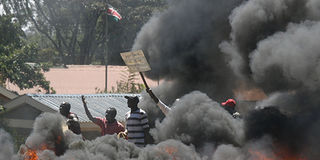Let it be known that poll violence is caused by rigging and incitement

Chaos in Naivasha in January 2008 after the General Election of December 27, 2007. The trouble with Kenya’s elections has always arisen not at the voting stage; not in the campaigning; and not even in the ethnic mobilisation, but at the counting and tallying. PHOTO | FILE | NATION MEDIA GROUP
What you need to know:
- It is encouraging to hear President Kenyatta say he, Mr Odinga and Mr Musyoka will ensure the next election cycle is violence free.
- It will be even better for the troika to first own the previous violence and apologise to Kenyans for it and for the interference that there has been in their polls.
President Uhuru Kenyatta desires to bequeath Kenyans a peaceful country rid, especially, of violent election cycles. That is, Mr Kenyatta wants to be remembered for bringing peace to Kenya’s elections in particular and the country in general.
PRESIDENTIAL POLLS
It is why, he says, on March 9 he formalised a pact with Mr Raila Odinga and, last week, roped in Mr Kalonzo Musyoka, the previously opposition duo whom he and Deputy President William Ruto defeated in the 2013 and 2017 presidential polls.
Are Kenya’s elections violent? Who causes the violence? Who engages in the violence? Implicit in the President’s portrayal of Kenya's elections is that they are seasons when Kenyans turn on each other in orgies of violence.
ETHNIC MOBILISATION
First I wish to submit that the trouble with Kenya’s elections has always arisen not at the voting stage; not in the campaigning; and not even in the ethnic mobilisation, but at the counting and tallying. That’s the tail-end of the process which does not involve the ordinary voter and voting.
RUDIMENTARY ARMS
Second, I wish to state that Kenya has had 11 General Elections and of these only pre-1992 and 1997 ballots and post-2007 and to a lesser degree 2017 polls, witnessed violence.
Third, it bears repeating that Kenyans are incited, set up, against each other at best or, incited into taking up crude and rudimentary arms against their neighbours, by politicians at war — politically — with each other.
POST-BALLOT TINKERING
Fourth, who bears the brunt of this violence unleashed by the rent-a-mob few at the bidding of even fewer malicious my-way-or-the-highway politicians? It is the ordinary people who live and play by the rules and look to the State for protection.
It is ordinary people who are disenfranchised by violent pre-voting rigging strategies and their clandestine post-ballot tinkering.
MULTIPARTY POLITICS
The 1990s violence in Western Kenya hit the vote-rich Rift Valley hardest because its architects sought to drive away non-Kalenjin supporters of multiparty politics ahead of the 1992 and 1997 General Elections.
When violence shifted to the Coast in 1997 the aim was to drive away communities from upcountry — Wabara — who were believed to vote against the then governing party Kanu and President Moi.
DOMINANT CLASS
The organised thuggery and gangsterism was carried out at the behest of the politically dominant class at first keen to stave off the rising tide of political pluralism and, later, to keep Kanu, which was on its last legs, in power.
It was not about Kenyans spontaneously or incrementally rising against each other because an election was coming.
MIGRANT COMMUNITIES
It is also significant to observe that the choice of Rift Valley and Coast are important especially in regard to migrant communities that were branded foreigners who had outlived their welcome. Latent yet popular land-based and wealth-related injustices were exploited to rig elections in advance.
DECLARED LOSER
Enter 2007. Bear in mind that the aftermath has been called post-election violence. This is both right and wrong. Right because a General Election ends when the results have been declared.
Wrong because the 2007 violence erupted in response to the declared results of the presidential poll and not about the results of the General Election. Why? The presumed winner was declared loser
LOST PROPERTY
Fifth, in the violence of the 90s the provincial administration and security services looked the other way as innocent people lost property, lives, livelihoods and loved ones. In 2007 and 2017 police visited terror on demonstrators.
The President holds that Mr Odinga bears political responsibility for the 2007 violence for which Mr Kenyatta was arraigned at The Hague. Mr Odinga holds that the President bears responsibility for the deaths in 2017 at the hands of the police.
DARK ART
I hold that both have exploited violence to further their political interests and therefore have blood on their hands. However, they now have an opportunity as leaders to design ways of saving us from themselves by ensuring that their dark political art of violence is expunged from our politics.
VIOLENCE CYCLE
It is encouraging to hear President Kenyatta say he, Mr Odinga and Mr Musyoka will ensure the next election cycle is violence free. It will be even better for the troika to first own the previous violence and apologise to Kenyans for it and for the interference that there has been in their polls.
NATIONAL DIALOGUE
Then the President, Mr Odinga and Mr Musyoka can expand their tent of peace by bringing in Deputy President William Ruto and opposition chiefs Musalia Mudavadi and Moses Wetang’ula or, even better, consider a national dialogue on peace and prosperity for Kenya.
[email protected]





